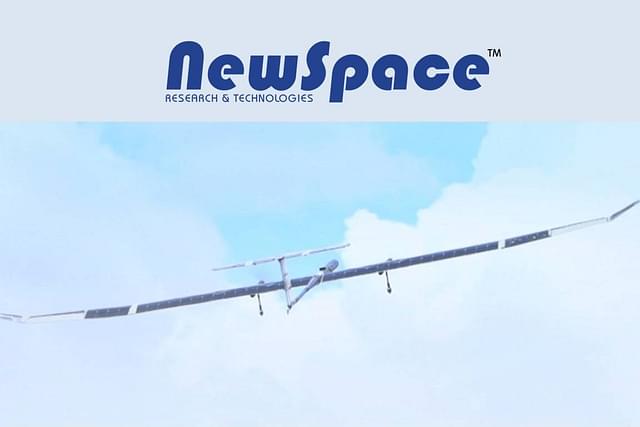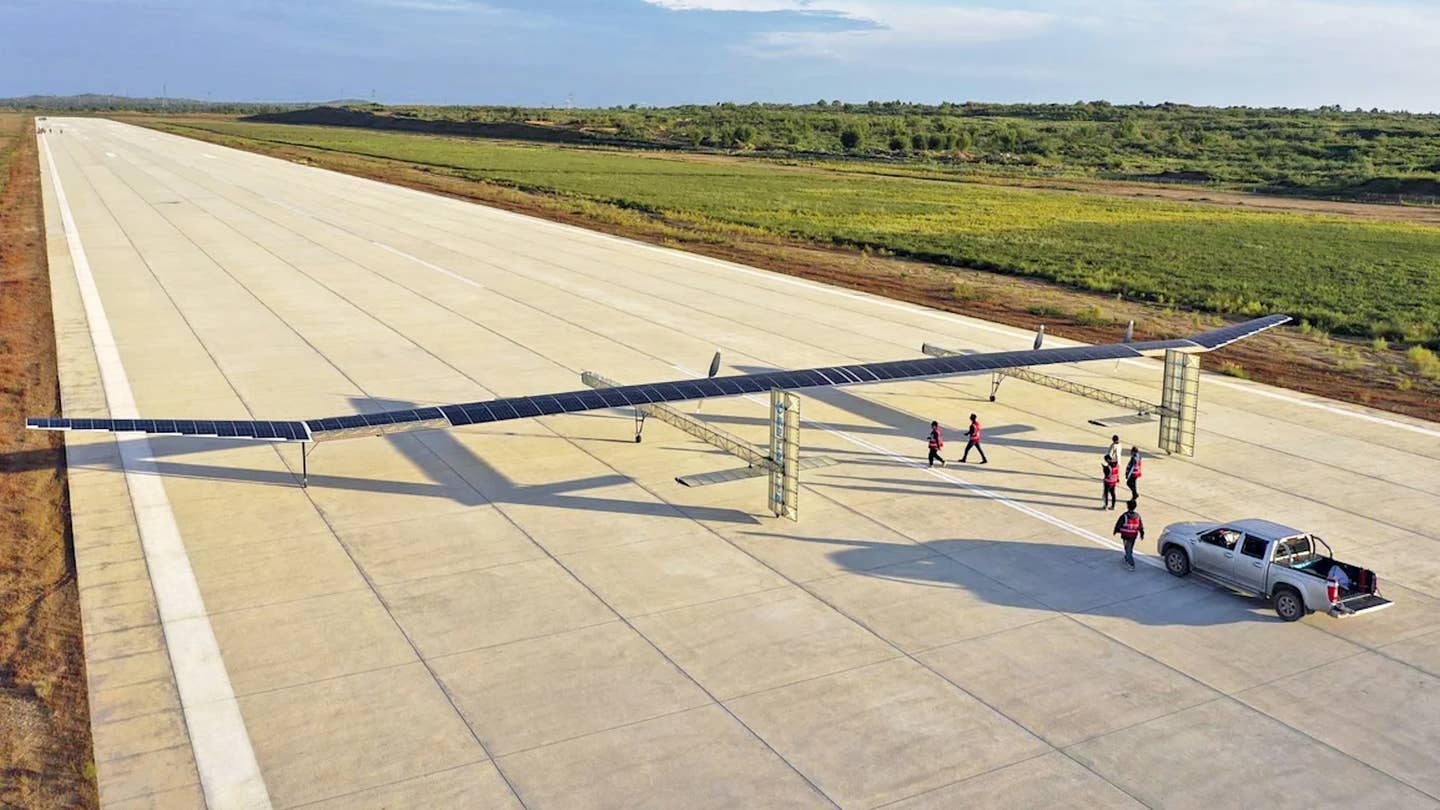https://www.thedrive.com/the-war-zo...durance-drone-has-flown-mirroring-u-s-efforts
China’s New Super Long-Endurance Drone Has Flown, Mirroring U.S. Efforts
Drones like the Qimingxing 50 can fly extremely high for very long periods and could replace military satellites in a pinch, among other uses.
BY
JOSEPH TREVITHICK,
OLIVER PARKEN|PUBLISHED SEP 7, 2022 4:42 PM EDT
THE WAR ZONE
AVIC’s Qimingxing 50 high-altitude drone.
Liu Feng/chinadaily.com.cn
SHARE
JOSEPH TREVITHICK
View Joseph Trevithick's Articles
FranticGoat
OLIVER PARKEN
View Oliver Parken's Articles
The state-run Aviation Industry Corporation of China, or AVIC, recently announced the first flight of a new high-flying solar-powered unmanned aircraft called the Qimingxing 50, or Morning Star 50. AVIC describes the drone as a "pseudo-satellite" intended to fly primarily in the stratosphere and says it could be used for various ostensibly civilian missions, including keeping watch for forest fires and conducting scientific research. However, unmanned aerial systems like this have a glaring potential for military applications. For example, the Qimingxing 50 is similar in many respects to
the Airbus Zephyr S, which was recently involved in
a high-profile U.S. Army test that unfortunately ended with the drone crashing.
AVIC said that the Qimingxing 50 drone conducted its first flight from an airport in Yulin, a city in the country's northwestern Shaanxi Province, on September 3. The drone took off at around 5:50 PM local time and was airborne for just 26 minutes before safely landing on the same runway that it had taken off from. "All systems on the unmanned plane functioned well," according to
a report from China Daily, an English-language newspaper operated by the Chinese Communist party, but no further details were given about the test, including how high the unmanned aircraft flew.
Qimingxing 50 core design consists of a single very long and relatively slender wing. It has two separate slender fuselages, each with a single tail and two stabilizers at the rear, attached to the underside of the wing. The drone's propulsion comes from six electric motors each driving a single propeller.
The unmanned aircraft's exact specifications are not immediately clear, but the combined length of the solar panels that cover the entirety of its wing
is reportedly 50 meters (164 feet). That figure suggests that the 50 in Qimingxing 50 could refer to the wingspan.
An aerial view of the solar-powered Qimingxing 50.
Liu Feng/chinadaily.com.cn
Qimingxing 50 is also understood to be bigger overall than an earlier Qimingxing design
that AVIC tested in 2018, which had a wingspan of 20 meters (just over 65.5 feet) and a gross weight of just 18.9 kilograms (just under 42 pounds). Video footage and pictures from the new drone's recent maiden flight show it is still light enough to be launched by hand by a team of individuals running down the runway holding it over their heads.
A side-view of the Qimingxing 50 being maneuvered into position on the runway.
Liu Feng/chinadaily.com.cn
Zhu Shengli, the head designer of the Qimingxing 50 at AVIC, said that the drone should be able to fly up to altitudes of at least 20 kilometers (nearly 65,617 feet),
according to China Daily, which is in the stratosphere. Zhu added that the drone has sufficient battery capacity to continue flying overnight and that it could potentially stay aloft for months or even years at a time, though it certainly has yet to demonstrate anything near that kind of endurance.
The Qimingxing 50 in flight above the runway.
Liu Feng/chinadaily.com.cn
"Calling the model a 'quasi-satellite,' Zhu said it features high operational efficiency and eco-friendliness and will be tasked with high-altitude reconnaissance, forestry fire monitoring, atmospheric environmental inspection, aerial mapping, communication signal relay, and other operations," China Daily reported. "He said the solar-powered drone will also help to advance the research and development in fields such as new energy, composite material, and aeronautical engineering. It will improve the country's operational capability in near space and oceans, the designer added."
All of these are definitely missions that could benefit from the Qimingxing 50's high-altitude and extreme endurance capabilities, as well as the operational flexibility it offers over actual satellites in space, which generally cannot be rapidly retasked from one area to another. Multiple drones working together as a sort of pseudo satellite constellation could perform those tasks across a very large area, or distinctly geographically separated areas, something that could be especially valuable for a country as large as China.
A close-up view of the Qimingxing 50 flying above the runway.
Liu Feng/chinadaily.com.cn
At the same time, it's not hard to see how persistent, high-altitude platforms could be useful for supporting military operations across broad areas while acting as sensor platforms, communications and data-sharing nodes, and relays for navigational data. A number of military forces around the world are exploring what generally similar drones might be able to offer while soaring over the battlespace.
This includes the U.S. Army's experimentation
with the Airbus Zephyr S, a drone design that is broadly similar in form and function to the Qimingxing 50, but is smaller overall. The Army's Zephyr S
crashed in Arizona last month after staying aloft for a record-crushing 64 days. In the course of that marathon sortie, the unmanned aircraft had also flown to the Central American country of Belize and back by way of the Gulf of Mexico and the Caribbean Sea. You can read more about this test
here.
The Zephyr S design, which is smaller than the Chinese Qimingxing 50, is also hand-launched by a team of individuals on the ground, as seen here.
US Army
Beyond just providing extra intelligence, surveillance, communications and data-sharing, and navigation support, pseudo-satellites like the Qimingxing 50 and the Zephyr S, could potentially act as backups for space-based networks that provide these kinds of capabilities. The drones could be relatively rapidly deployed to take over key tasks if orbital assets are damaged, destroyed, or otherwise rendered inaccessible during a major conflict. There are very real threats to orbital assets, including from various
terrestrial anti-satellite systems and
others in space, now and they are only likely to grow as time goes on. There is simply the risk of potentially serious accidents in space
due to debris and
other factors.
With all this in mind, Qimingxing 50s could also be used to help restore important access to cellular telephone or internet networks in the aftermath of a disaster of some kind, on Earth or in space.
The Qimingxing 50 being transported off the runway after its test flight.
Liu Feng/chinadaily.com.cn
It remains to be seen how the Chinese might actually employ examples of the Qimingxing 50, or future Qimingxing-series designs, in civilian or military roles. This particular design still very much has to prove its ability to fly at extremely high altitudes for long periods of time. As the crash of the Zephyr S during the recent Army test made clear, operating a very long-endurance drone, which are ultralight flying marvels in their own right, in the stratosphere and getting it back down safely
present challenges.
What is clear is that China's state-run aviation industry is making at least some amount of progress in its development of drones of this kind, and very large examples at that, which could easily have military, as well as civilian applications.









